When we want homemade bread without the hassle, this french bread recipe is GOLD. It's kneaded in the food processor in 45 seconds! There is waiting time after that, but very little hands-on work. The crust is crackly, and the inside is soft and creamy. Crusty French bread at its best, and with a video tutorial!
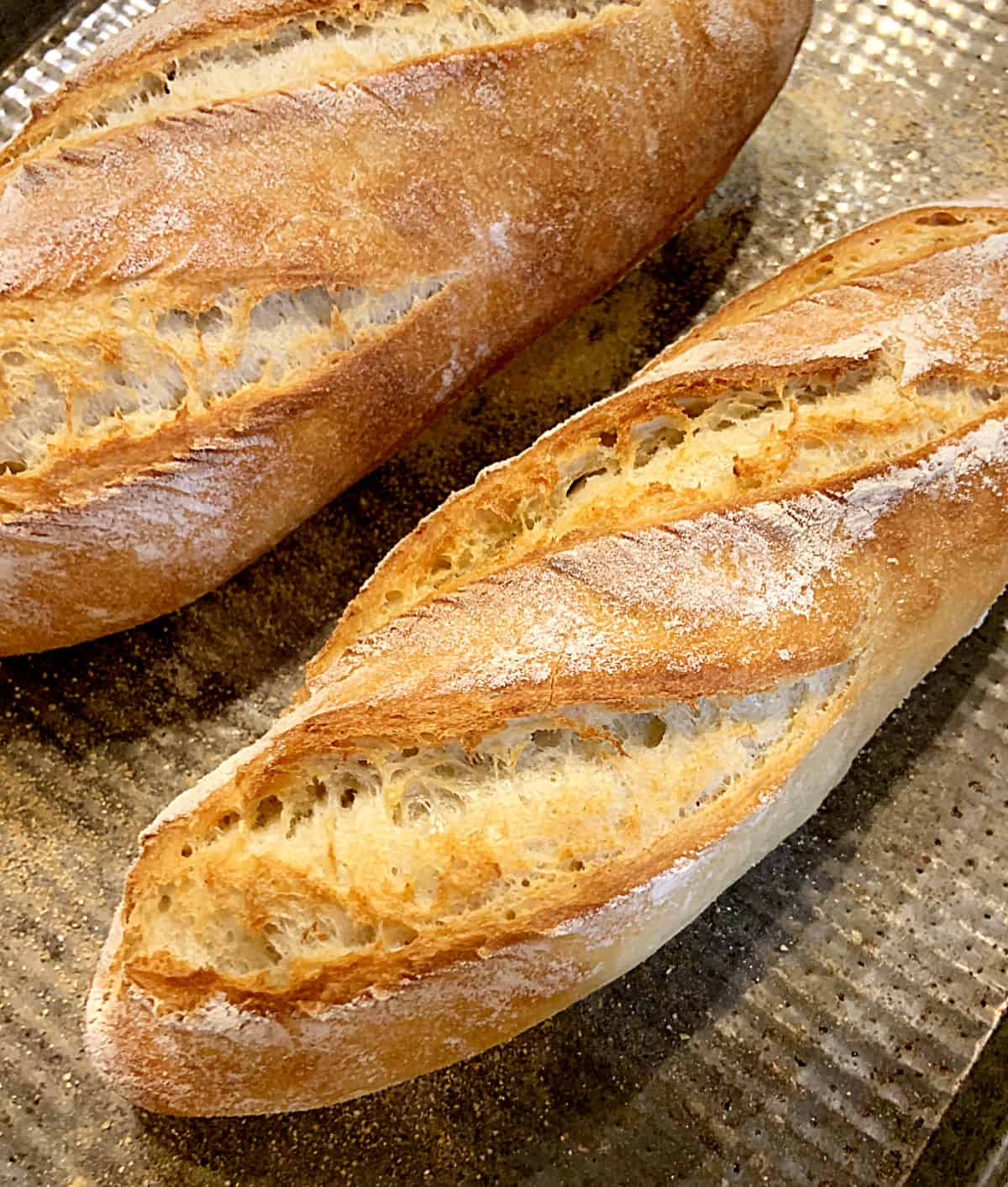
As an Amazon Associate, I earn from qualifying purchases. Please read my disclosure policy.
I started making this bread recipe years ago. I would make a double batch, form it into individual sandwich-sized loaves and freeze them.
Or eat a freshly baked loaf in a matter of minutes; that also happened sometimes. Warm with a dollop of butter this bread is fantastic!
During the 2020 bread-baking craze, I dusted off this recipe and made it with regular white bread flour and superfine whole wheat flour. Both are amazing! The latter is more rustic and doesn't completely develop that crackly crust, but that is minor compared to the easiness of this recipe.
I love making homemade bread. The aroma in the kitchen is unparalleled, as are those first warm crusty bites.
For breakfast and sandwiches, I tend to lean towards fiber-laden ones like this whole wheat oatmeal bread recipe that is versatile and delicious. For bruschettas, there's nothing like this Italian semolina bread.
So, let's go straight into the details of making this French bread.
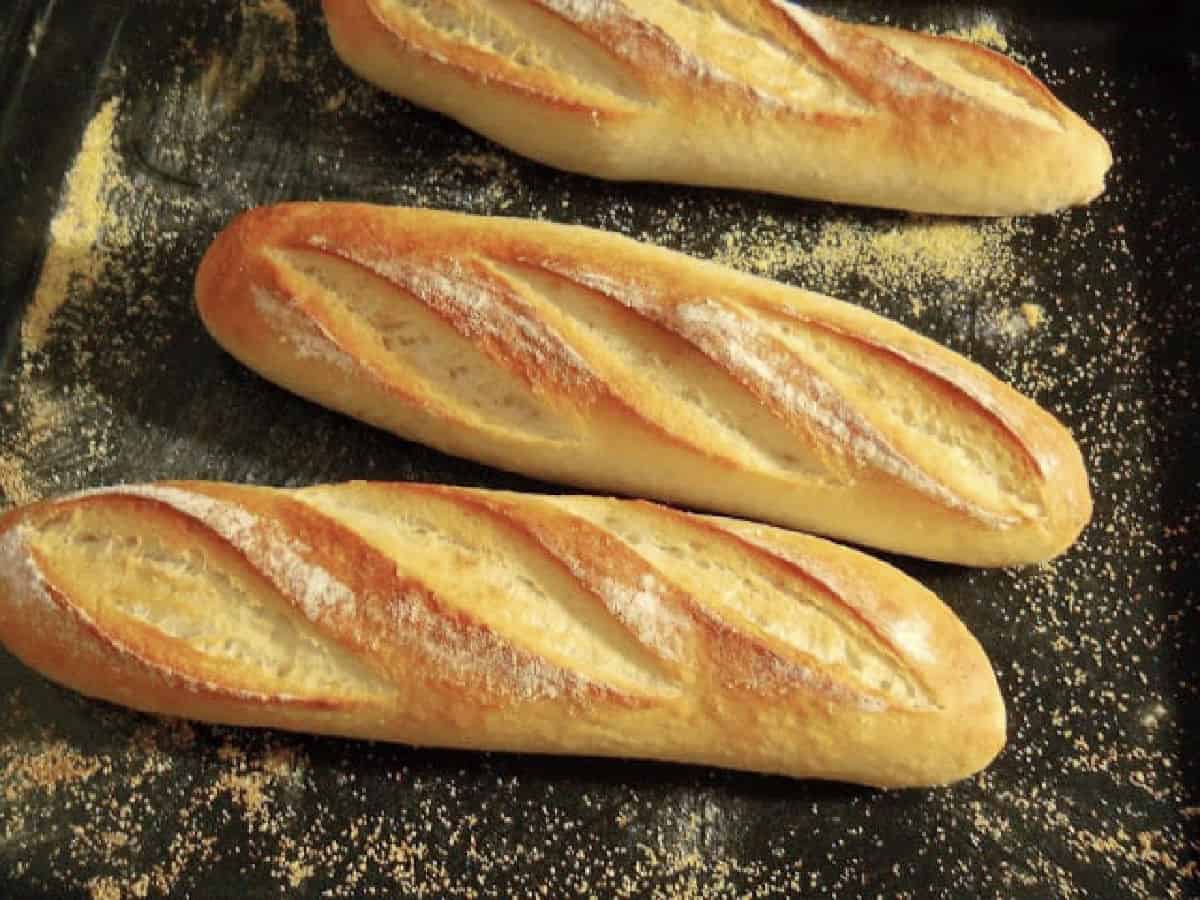
Ingredients
They are few, and you probably have them all in your pantry.
French bread, in essence, is the recipe with the fewest ingredients because it only uses flour, salt, yeast, and water.
- Yeast: for this recipe, you need dry instant yeast.
- Flour: depending on where you live they have different labels. I use bread flour, and I highly encourage it, as it has more protein, thus developing more gluten which makes for a better rise and crumb. All-purpose will work if that's all you have.
- Salt: I like to use kosher salt when baking. But regular table salt works just fine.
- Water: it should be tepid, and you can use mineral water or regular tap water. Be careful not to use hot water as it will greatly diminish the yeast's strength or kill it altogether, and the bread won't rise. Slightly warm or tepid means that you can dip your pinky finger and it will be barely warm.

Watch our step-by-step videos
How to make baguettes
You'll love how easy it is to make this recipe! There is some waiting time to allow the yeast to render its magic, but besides that, little hands-on work.
- Time is the most important step and makes this french bread recipe easy. You only need to process the dough for 45 seconds! Yes, that's right, less than a minute.
- Food processor: it's the necessary appliance for this recipe. Use one that is large enough to hold all ingredients comfortably.

Make sure the salt and the yeast are not touching before adding the water, as it can reduce the latter's strength if that happens. They will combine once the liquid is added.

Mixing: the process for making this dough is simply putting the ingredients in the bowl of the food processor with the steel blade and adding the water through the feed tube while the food processor is running.
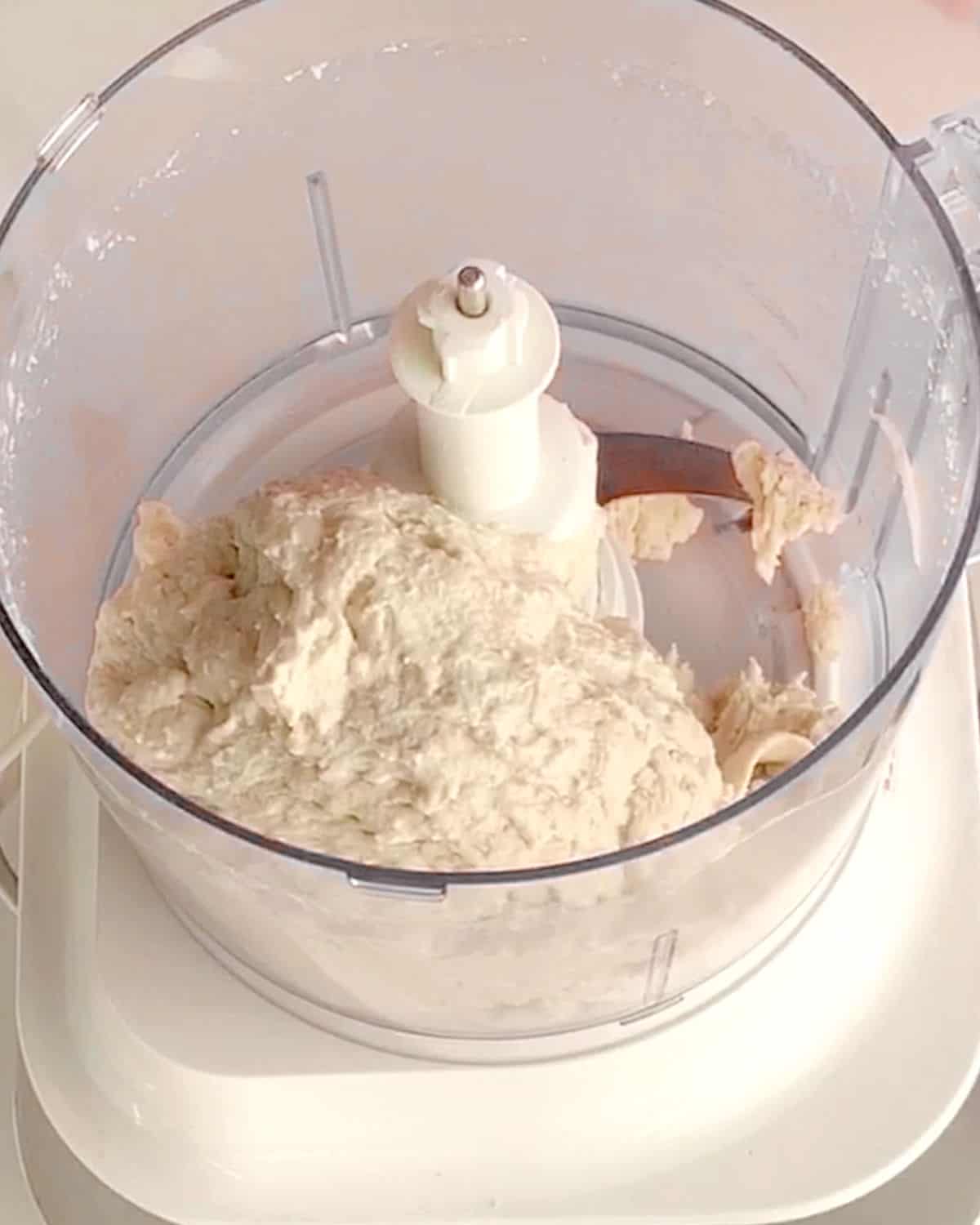
Dough: it will be rustic, not smooth at all. You then have to let it rest for a couple of hours. The dough won't rise until doubled so don't worry if it has hardly changed in appearance. But it will be softer and more relaxed.
Forming and scoring the loaf
Baguettes or batards: they are French names that distinguish the type of loaf. The baguette is thinner and longer (more crust than crumb), and the batards are plumper and shorter (more crumb than crust).
How to form them?
Scoring: this refers to the slits that are made on top of the loaf right before it goes into the oven. This helps the bread to rise evenly.
Scoring razor: if you plan on making French bread often, I highly recommend buying a bread lame for dough scoring, which is a stick with a razor blade that makes clean slits.
Using a sharp kitchen knife is the homemade version, and the slits are not always as slick. See the image of the bread in the oven below for how irregular the cuts are when made with a knife. They still work though! Don't get me wrong. But the blossoming might not always be as it should.
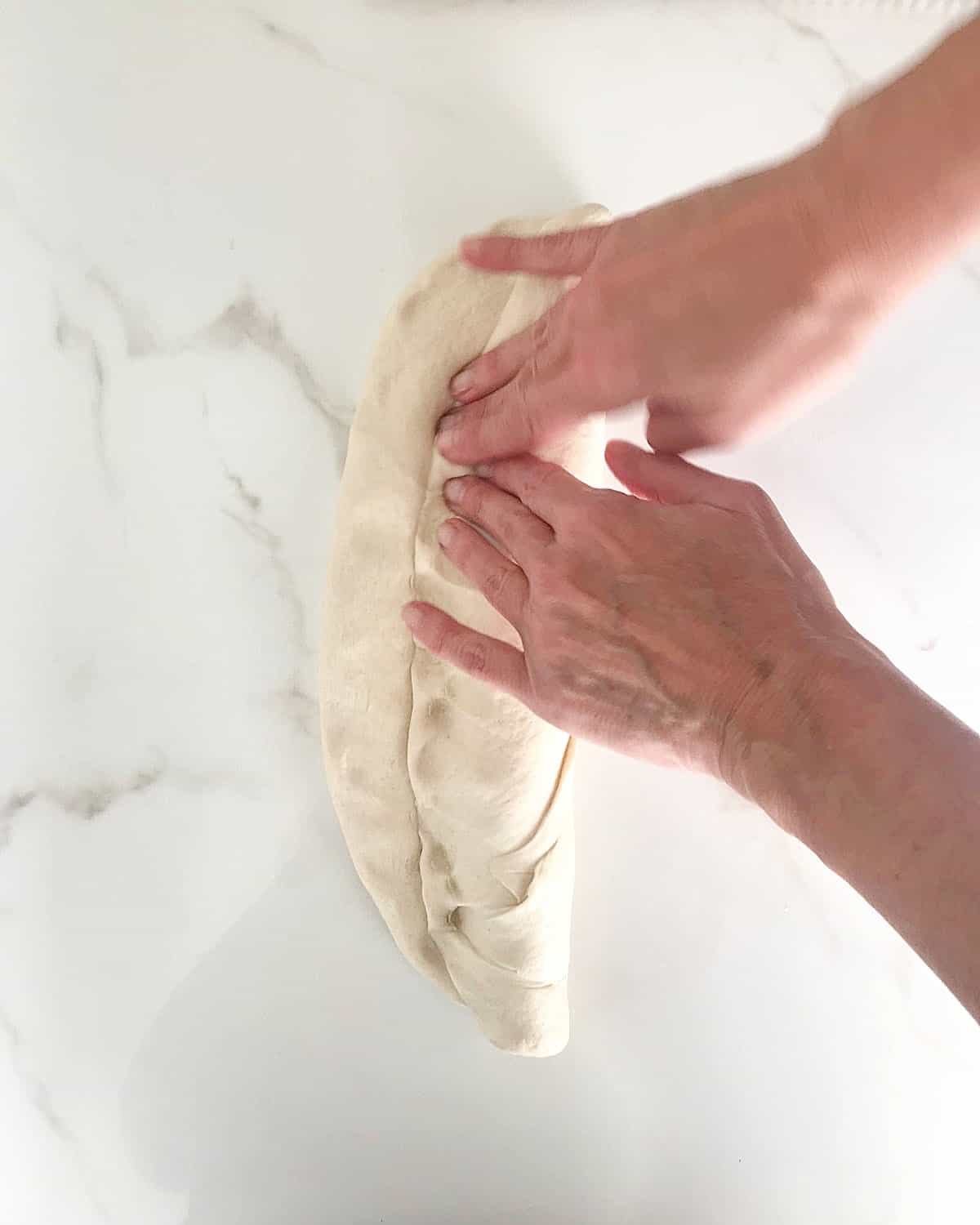
Make a rectangle and roll it up with your hands like cinnamon rolls. Important: pinch the seams each time you roll the dough to keep out as much air as possible.

Use a lame (a stick with a razor blade that can be bought online) or a sharp knife.
Vintage Kitchen tip: Don't be tempted to make very deep slits as they will blossom too much during baking.
Baking the bread
Oven: this is where the magic happens, and it's highly recommended to put a pan with hot water on the bottom of the oven to create steam while the bread bakes. It helps to create that fabulous crackly crust that we all love!
When is it done? The bread will turn a golden brown, and the slits will open. The way to know if it is fully baked is by turning it upside down (carefully because it's very hot, so use a kitchen towel) and tapping the bottom of the bread. It should sound hollow and not be very soft. That's when the bread is done.
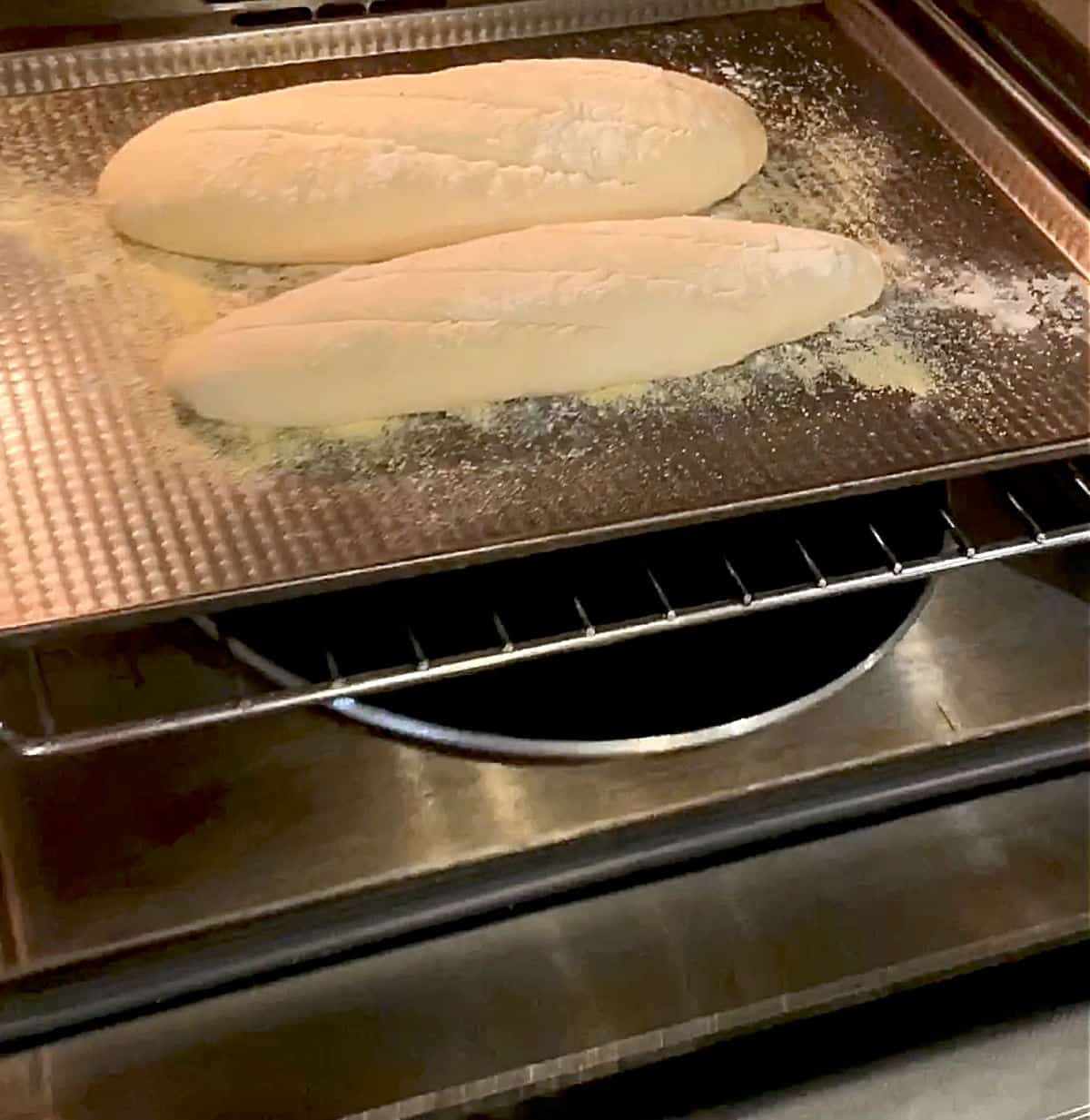
Kitchen notes
- Organization: read the recipe first and ensure you have ingredients at the correct temperature, equipment, and enough workspace. This will make the process so much easier.
- Baking time: keep in mind that all ovens and pans are different, even if they look the same or very similar. The baking time in my recipes is as accurate as it can be, but it might take you more or less time. You can use a thermometer(like the OXO oven thermometer) to check that your oven is at the right temperature. I recommend you keep track of how your oven works and what tiny details you might need to adjust.
- Time: this is a no-knead bread, but you need resting and proofing time (when the yeast does its magic), so plan accordingly.
- Flour: you can use white bread flour, all-purpose flour, or superfine whole wheat flour. With this last one, the bread will be more rustic and not have that crackly crust, but it renders a fantastic healthier bread.
- Oven: it's highly recommended that you follow directions for both the temperature and the pan with water in the bottom. This will aid in getting the best results possible.
- Storing: French bread is best about half an hour out of the oven (when it had time to cool down a bit) and those few hours after. You can keep it in a bread bag at room temperature, but it will lose the crackly crust. Unless you warm it before eating. You can't bring it back completely to its original state, but it'll be wonderful. And you can freeze this bread (I recommend slicing it thickly, wrapping it in plastic, and then in foil or a Ziploc bag).

Frequently asked questions
They are both the same. A baguette is a French bread shaped like a stick, long and thin, and the name used for this type of bread in France.
French bread is the simplest type of bread, using a few ingredients (flour, salt, yeast, and water), with a crackly crust, and a more airy crumb. Italian bread can be more sophisticated, with a denser crumb with a coarse crust, and often includes durum flour (a type of flour used for making pasta) such as our very popular Semolina Bread recipe.
Absolutely! And I recommend doing so if not eating in the first hours of making it as it can harden or become too chewy pretty fast.
If you mean white sandwich bread then no, not at all. But French bread is white in the way that it's made with white wheat flour as opposed to whole wheat for example.
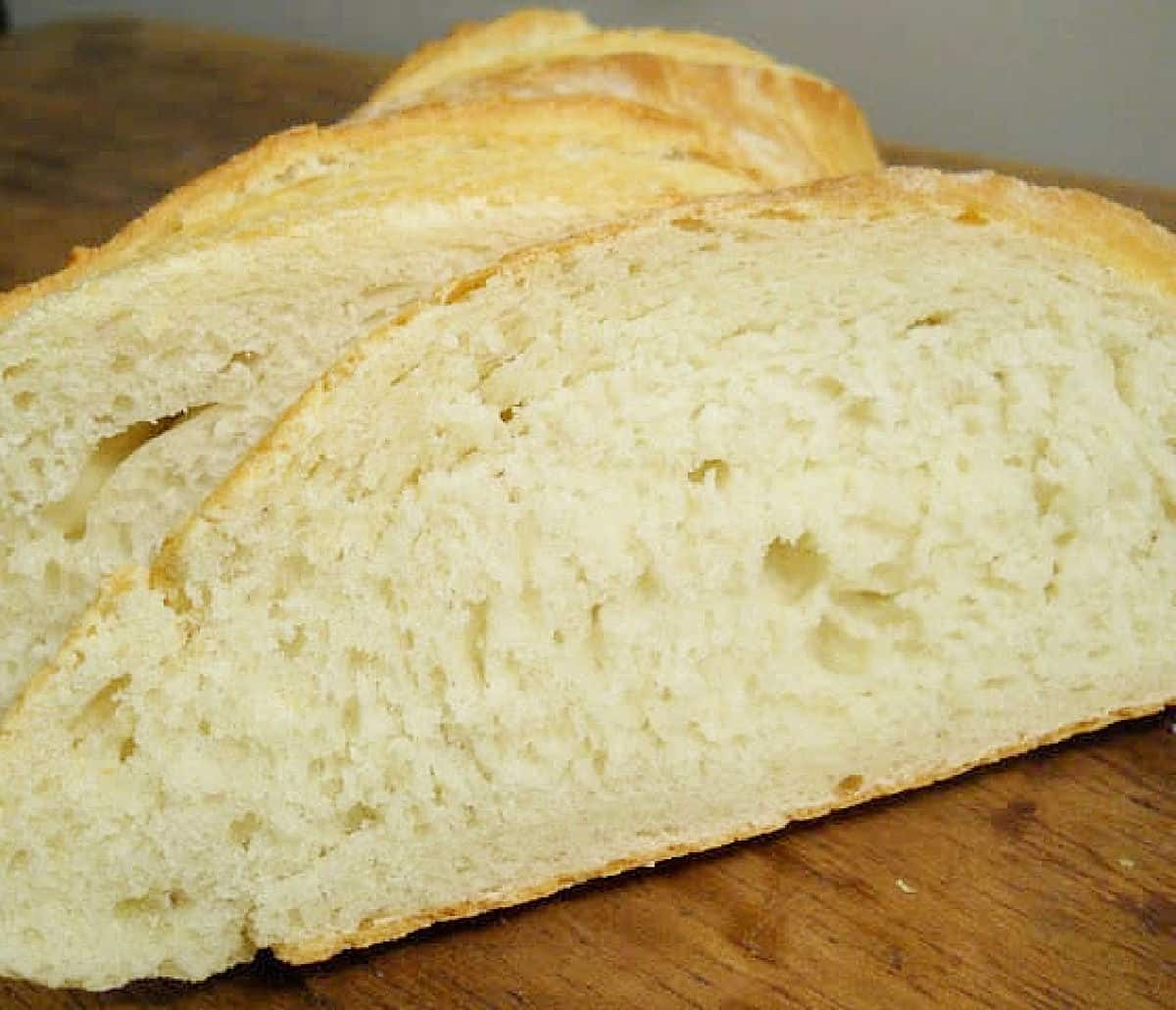
OTHER BREAD RECIPES YOU'LL LOVE:
Let me know in the comments below if you made this recipe and loved it and if you had issues so we can troubleshoot together. I love to hear what you think, always. Thanks for being here. It's much appreciated.
You might also consider subscribing to our FREE Baking the Best email series and our regular newsletter. Or connect via Facebook, Instagram, and Pinterest.

Crusty French Bread Recipe
When we want homemade French bread without the hassle, this baguette recipe is GOLD. It's kneaded in the food processor for 45 seconds! There is waiting time after that, but very little hands-on work. The crust is crackly, and the inside is soft and creamy. So if you're intimidated about baking bread at home, this is the perfect recipe. Crusty French bread at its best.
- Total Time: 3 hours 40 minutes
- Yield: 3 medium
Ingredients
- 3 ½ cups (500g) bread flour
- 2 teaspoons (12g) salt
- 1 teaspoon (3.5g) instant dry yeast
- 310g (1 ⅓ cup) slightly warm tap water
Instructions
- Put the flour in the bowl of the food processor.
- Add salt on one side and yeast on the other, you don’t want them to touch for now.
- Cover with the lid and begin to process at medium/high speed.
- Add the water through the feed tube as you begin counting 20 seconds. Either do it out loud or use the phone timer. You’re going to see the dough starts to come together.
- Stop the machine after 20 seconds and see that it is not dry. It should be rough; make sure there are no spots of flour at the bottom. If it is dry, add 1 more tablespoon of tepid water.
- Cover the bowl back and now process for 25 more seconds. It should be 45 seconds in total.
- Transfer the dough to a dry bowl, cover it with plastic wrap, and put it in a warm place for 2 hours. The dough is hardly going to rise or double, and that is fine.
- Dump it onto a lightly floured counter, and divide it into 2 or 3 pieces.
- With each piece, make some rough buns by cupping them with both hands until you have a smooth surface, cover them with a clean kitchen towel or loose piece of plastic wrap, and leave them alone for 20 minutes.
- Flatten each piece of dough on the counter (flour it lightly if needed) and shape them into baguettes. I like to make them shorter and thicker.
- Put them on an oven sheet pan sprinkled with polenta or oatmeal on the bottom, and dust the bread pieces with a little flour. Cover and let stand for 40 minutes.
- About 15 minutes before baking, turn on the oven at 450°F / 230°C.
- Have ready a roasting pan and a kettle of hot water.
- When the 40 minutes are almost over, put the roasting pan on the bottom of the oven and carefully fill it halfway with hot water. Close the oven door. This creates steam that is great for forming that crackly crust.
- Make 3 cuts or slits to each loaf with a lame (find where to buy it online in the Notes below) or a very sharp kitchen knife, and immediately put it in the oven.
- Cook for 25-30 minutes, until golden brown and they sound hollow if you turn them over and lightly tap the bottom with your fingers.
Notes
- Organization: read the recipe first and ensure you have ingredients at the correct temperature, equipment, and enough workspace. This will make the process so much easier.
- Baking time: keep in mind that all ovens and pans are different, even if they look the same or very similar. The baking time in my recipes is as accurate as it can be, but it might take you more or less time. You can use a thermometer(like the OXO oven thermometer) to check that your oven is at the right temperature. I recommend you keep track of how your oven works and what tiny details you need to adjust.
- Time: this is a no-knead bread, but you need resting and proofing time (when the yeast does its magic), so plan accordingly.
- Flour: you can use white bread flour, all-purpose flour, or superfine whole wheat flour. With this last one, the bread will be more rustic and not have that crackly crust, but it renders a fantastic healthier bread.
- Oven: it's highly recommended that you follow directions for both the temperature and the pan with water in the bottom. This will aid in getting the best results possible.
- Storing: French bread is best about half an hour out of the oven (when it had time to cool down a bit) and those few hours after. You can keep it in a bread bag at room temperature, but it will lose the crackly crust. Unless you warm it before eating. In this case, you can't bring it back completely to its original state, but it'll be wonderful. And you can freeze this bread (I recommend slicing it thickly, wrapping it in plastic, and then in foil or a Ziploc bag).
- Prep Time: 10 minutes
- Resting time: 3 hours
- Cook Time: 30 minutes
- Category: Bread
- Method: Baking
- Cuisine: International
Nutrition
- Serving Size: ⅛
- Calories: 218
- Sugar: 0.2 g
- Sodium: 584.4 mg
- Fat: 1 g
- Carbohydrates: 43.7 g
- Fiber: 1.6 g
- Protein: 7.4 g
- Cholesterol: 0 mg


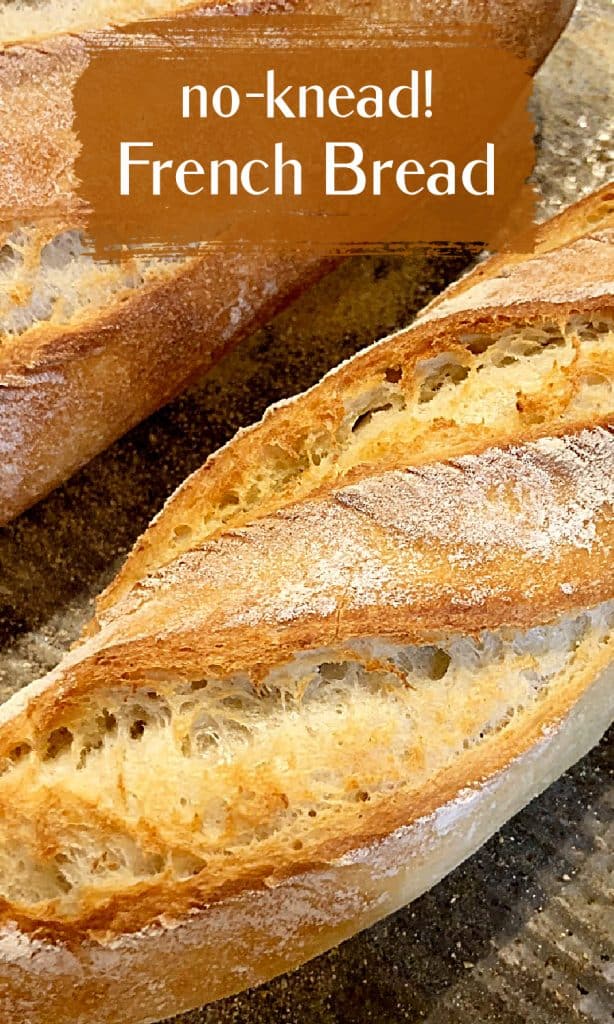
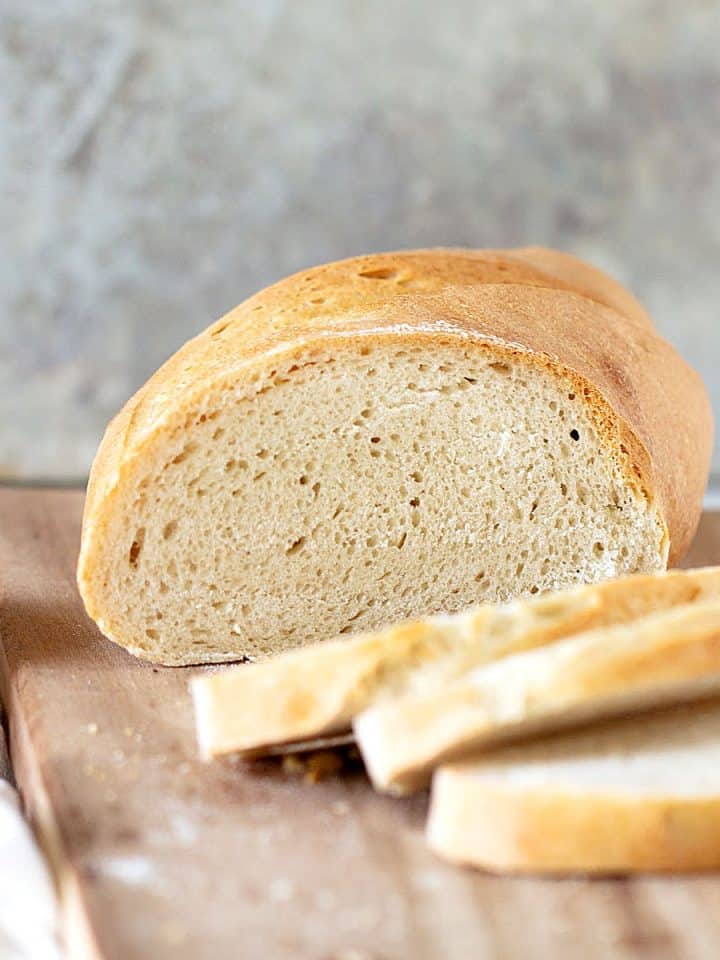
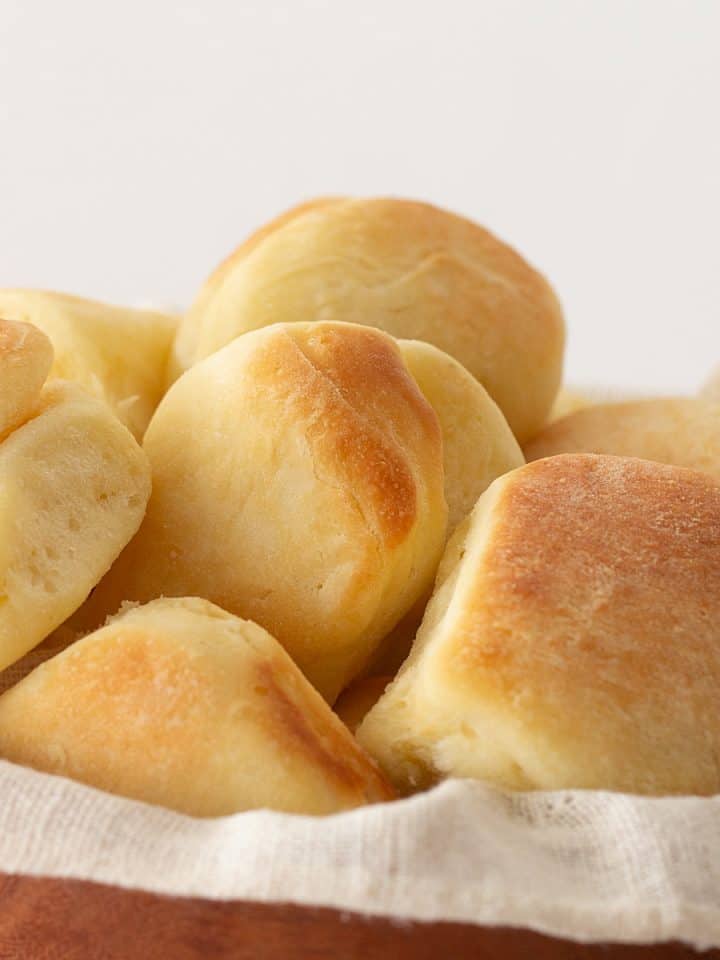
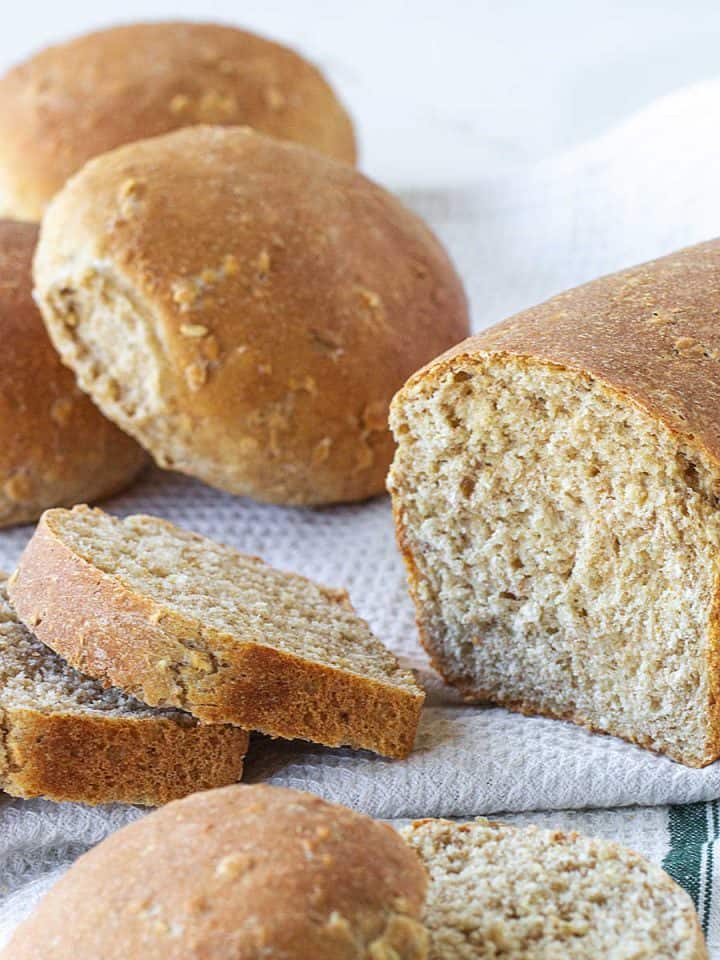
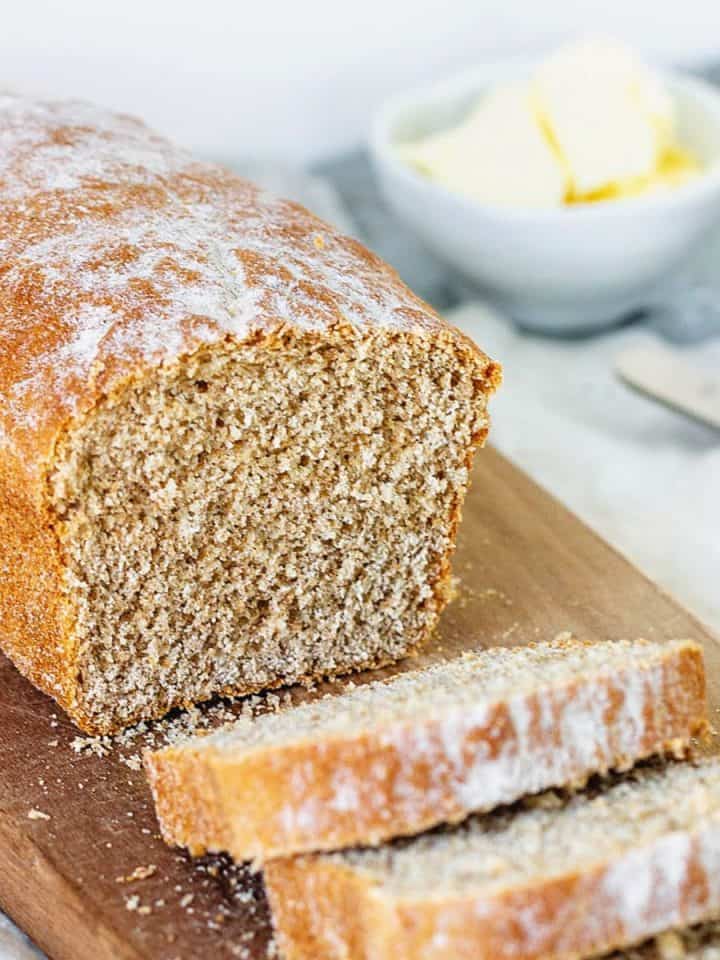
Salma says
Very easy and simple directions resulting in a great baguette. I have made it a few times and plan to make with some add-ins in the next couple of days. Thank you!
Roger W Kling says
I’m anxious to give this recipe a go. I have a gas range and I’m wondering if the type of oven, i.e. gas or electric, make a difference in the steam required for the crispy crust? Thank you.
Paula Montenegro says
Hi Roger! You should have no issues with a gas oven if using the roasting pan method. Years ago, I used a spritzer with water or directly throw some hot water in the bottom of the oven right before I closed the door, and some water reached the flame and put it out. But that won't happen with a pan and hot water. You'll only create steam.
Lori says
This is the BEST (and easiest) French bread recipe I have used. I bake quite a bit of bread and this recipe I’m has become my go to for baguettes. Once I learned to let it bake long enough (my first couple of attempts I pulled it out too early) Thank you!
Mary Jo Gallagher says
I can’t wait to try it
Sesinn says
I made this recipe and let the dough develop overnight in the fridge. Probably around 20 hours. I shaped it and let it rise, then baked it. I sprayed the bottom of the oven to create steam to form the crust. It baked up nicely in the texture department, however it had no colour. I made a blond baguette! There is a French man living where I work and he said it was good. I felt I could have put a Tbsp of sugar in it to help the yeast wake up more. I'll use the recipe again... Thanks.
Gerald Emile Brun says
I guess one coild also use a stand mixer, if no food processor is available.
Would you be so kind to indicate the necessary adaptation steps?
Gerald Emile Brun says
Great, simple recipe with good results.
Please correct a typo in your quantity factoring gor X2 and X3 flour measurements. They wrongly both list 500 grams.
Best
Sharon Bee says
I have made your recipe a few times now and it seems to get better each time. I have even added dried cranberries and sliced almonds to some or even a hint of molasses and raisins and they all have turned out awesome and so delicious. I was thinking about making some and giving away as christmas gifts this year. Thank you for sharing your recipe.
Paula Montenegro says
Thanks for letting me know Sharon! I love the idea of add-ins and giving them as gifts. Have a great holiday season!
Dana says
This looks simple and delish! I don't own a mixer or food processor. Is there a way to adapt this by kneading on the countertop?
Paula Montenegro says
Hi Dana! The recipe ingredients are traditional, so you can definitely knead the old-fashioned way.
Shannon Fetzer says
This is so easy and comes out great every time
Paula Montenegro says
Thanks Shannon!
Rsp says
This is an excellent little tutorial and takes the mystery out of making bread. Even a beginner would succeed. Just one note: while the bread is perfectly acceptable, I found it lacking in flavor. A long initial rise -- 12 hours or more -- is the only way to get great flavor. Rest it in the fridge overnight. Then a second rise....
Sarah says
How long did you let it rise the 2nd time?
Paula Montenegro says
Hi Sarah, it's 2 hours the first time and then 20 minutes for the pieces of dough, and 40 minutes after you form the baguettes. It's all in the recipe card.
Sarah says
Thanks, but I was asking how long the commenter above let their dough rise after letting it rest in the fridge for 12 hours.
Paula Montenegro says
Oh, I didn't realize that as I answered from the dashboard. Have a great week Sarah
Monica says
Did you get an answer on the length of 2nd rise after 12 hour refrigerator rise?
Janith Smith says
I don't have a food processor. Can this be made in a high powered blender?
Paula Montenegro says
Hi Janith, I never tried it and can't really guess as a blender has a very different speed than a processor and I don't know if it'll mix the ingredients well.
Lynne says
I was looking for a recipe for crusty French bread that was easy, and that I could freeze. This one checked all the boxes. I’m baking my second batch today!
Paula Montenegro says
Wow Lynne, love that! We make it regularly also; such a simple way of having fresh bread. Have a great week.
Cheryl says
This bread is so good. A little fussy with timing but so worth it! Any idea how you could use it for a Stromboli regarding timing. Not sure you want the meat and cheese in the stuffing to sit at room temp for 40 minutes for the last resting. It would make a wonderful crust.
Paula Montenegro says
Hi Cheryl! Happy to know you liked it. As for making stromboli, I never used this particular recipe to make filled bread.
But you can make a test run with a small amount of dough, fill it, and bake it directly. It won't be as doughy, I suppose, but stromboli doesn't puff much, so it'll probably be ok in that area. Make sure you make 2-3 slits on top with a sharp knife before baking, to let steam escape.
Personally, I don't mind filling it after the first rise and letting it rise again before baking. But I know you're hesitant to do so.
Either way, I'd do a test run with a small piece of bread dough first. You don't want to waste cheese and deli meats. Hope this helps. Happy baking!
Susan Celestino says
Just finished making this bread….YUMMY! ABSOLUTELY DELICIOUS!
Paula Montenegro says
Happy to know you loved it Susan!
Krystal says
First time I've ever made anything like this. Banana bread was my only bread baking experience. This was super easy and so tasty. My new go to recipe if I'm going to be making subs.
Paula Montenegro says
SO happy to know that you liked it Krystal! It's great for beginning bakers. Have a great week!
Maggie B says
I made them and they are beautiful! I need to take a few minutes off bake time, next go, they were a bit dark but oh so good! Thanks for the recipe, the first I tried was epic fail. So
Paula Montenegro says
Happy to know this Maggie! Bread takes practice. Have a great week!
Pat says
Pat:
Is it possible to freeze the dough, rather than the cooked bread?
Paula Montenegro says
Hi Pat! I never tried it with this recipe. I'm guessing you can, but can't say more than that. I have done it with other bread doughs with great results. Have a great week.
Michelle says
Did not turn out the same way as in the pictures. Not sure why...dough was very goopy compared to the pictures.
beth says
this bread is awesome make sure you use all the salt.. it’s easy to make abs delicious
Paula Montenegro says
Happy to know you liked it Beth!
Alanna says
My bread didn't really brown on the top - any suggestions?
Paula Montenegro says
Hi Alanna! Did the bread bake well inside? The crust might have to do with your oven settings, not enough heat coming from the top or the temperature being off.